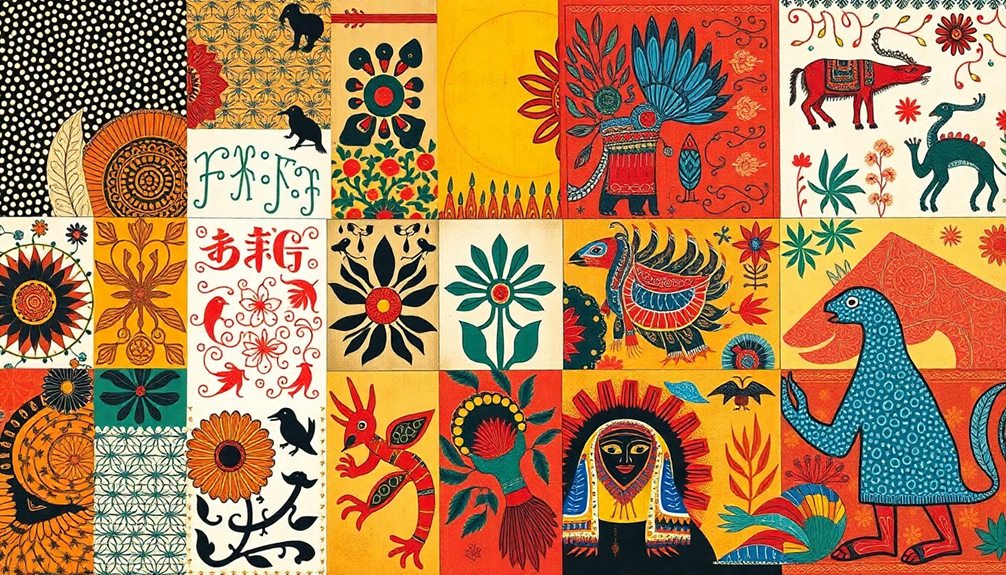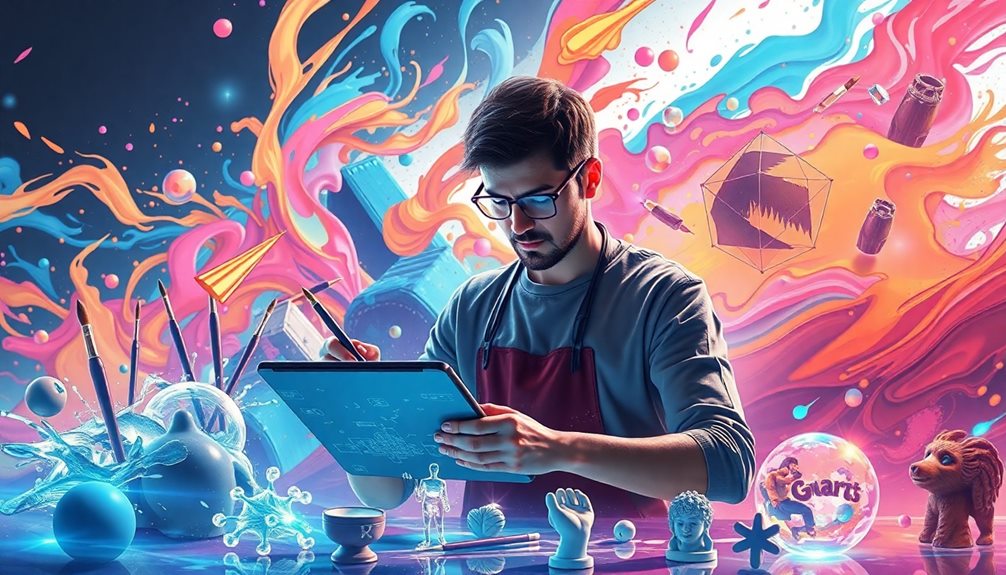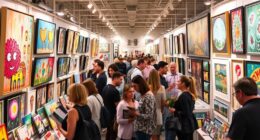Art and politics are deeply intertwined, each influencing the other. You'll find that art comments on political events and shapes social movements. Various artistic movements respond to societal issues, from Realism highlighting the struggles of the working class to Surrealism critiquing capitalism. To analyze political art, consider the historical context, symbolism, and the artist's intentions. Techniques like examining visual elements and contextual factors can enhance your understanding. This interplay not only raises awareness but also inspires action and dialogue. If you stick around, you'll uncover even more insights about this fascinating relationship.
Key Takeaways
- Art serves as a powerful medium for political commentary, reflecting societal issues and inspiring social change through various artistic movements.
- Historical context is essential for understanding the relationship between art and politics, revealing how artists respond to political climates and events.
- Symbolism and iconography in art carry deep political meanings, influencing audience interpretation and evoking emotional responses.
- Grassroots political art mobilizes communities and invites dialogue, transforming public spaces into platforms for social expression and activism.
- Analyzing the visual elements and compositional techniques of artworks enhances appreciation and understanding of their political dimensions and cultural significance.
Intersection of Art and Politics

The dynamic interplay between art and politics reveals how deeply intertwined these domains can be. As you explore this intersection, you'll notice how artists harness their creative talents to comment on political events and ideologies. Through visual analysis, you can see how artworks often reflect societal values and beliefs, making them powerful tools for critique.
Public art plays a vital role in shaping social movements, offering a platform for collective expression and engagement. It captures the spirit of the times, mobilizing communities and raising awareness about significant issues. You might find that political themes frequently emerge in artistic expression, as artists respond to contemporary challenges and injustices.
This relationship between art and politics isn't static; it evolves with cultural contexts, influencing how messages are conveyed and interpreted. As you investigate deeper, consider how different art forms—be it paintings, murals, or installations—serve as mediums for political commentary.
Historical Role of Art

Art has always played an essential role in shaping political landscapes throughout history. It reflects and catalyzes political movements, influencing social change in profound ways. Various art movements have emerged in response to significant political upheavals, illustrating this relationship.
| Art Movement | Political Context |
|---|---|
| Romanticism | Reaction against the Industrial Revolution and social injustices |
| Futurism | Alignment with fascist ideologies, glorifying violence and technology |
| Surrealism | A counter to capitalist and war ideologies, challenging bourgeois values |
Historical examples like the Civil Rights Movement demonstrate how art mobilizes social movements, using powerful imagery to raise awareness of critical political issues. Street art during the Arab Spring also underscores art's role in promoting political dialogue and change.
The Age of Enlightenment further influenced artistic expression, emphasizing reason and individualism, which shaped the political landscape of that era. By using art to challenge existing norms and provoke thought, you can see how it serves as an indispensable tool in the ongoing struggle for justice and equity. Embracing this historical perspective allows you to appreciate art's transformative power in political discourse.
Artistic Movements and Ideologies
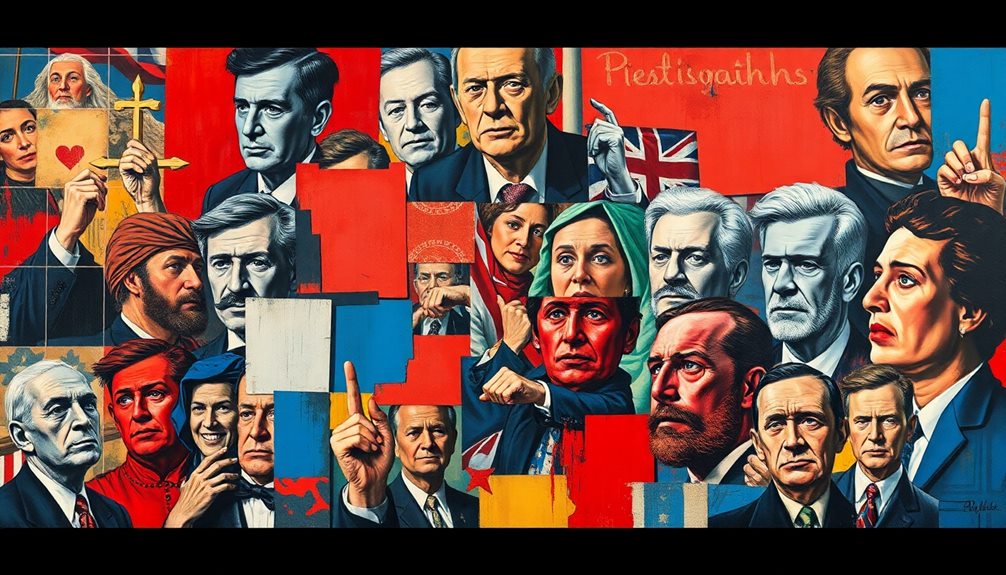
Throughout history, countless artistic movements have emerged, each reflecting and responding to the prevailing ideologies of their time. Realism, for instance, arose in the 19th century, focusing on the accurate representation of everyday life and highlighting social issues, particularly the struggles of the working class.
In contrast, Futurism celebrated modernity and technology in the early 20th century, aligning itself with fascist political ideologies that glorified violence and war.
Dadaism emerged as a reaction to World War I, rejecting traditional artistic norms and promoting anti-war sentiments through absurdity and irrationality.
Surrealism, on the other hand, sought to explore the unconscious mind, challenging bourgeois values and often aligning with leftist political movements to critique capitalist society.
Finally, Socialist Realism became the officially sanctioned style in the Soviet Union, portraying idealized scenes of labor and the working class to promote communist ideology and instill socialist values.
These artistic movements illustrate how artists use their work to engage with and comment on political ideologies, social issues, and the world around them, shaping cultural narratives and influencing public perception.
Analyzing Political Dimensions

Exploring the political dimensions of an artwork requires delving into its historical and cultural context, which reveals the societal issues the artist addresses. Understanding this context helps you grasp the intent behind the political art and how it relates to the issues of the time.
Pay attention to the symbolism and iconography, as specific motifs can carry deep political meanings that provoke critical thought and resonate with viewers.
Consider the formal elements, such as composition and color, which can influence audience reception and guide interpretation. A well-composed piece might elicit a different reaction than one with chaotic elements.
The artist's intentions matter, but so do your interpretations; personal perspectives shape how you understand the political message.
Moreover, ethical considerations like propaganda and censorship highlight the responsibilities of both artists and audiences. Engaging with political art means recognizing these complexities and being aware of how societal factors influence your understanding.
Impact of Political Art

Political art serves as a powerful catalyst for social change, pushing you to reflect on critical issues and inspiring action.
Whether it's through the stirring notes of a protest song or the striking visuals of street art, these expressions empower grassroots movements and amplify voices that need to be heard.
As you engage with this art, consider how it challenges norms and sparks conversations that can lead to real transformation.
Social Change Catalyst
Catalyzing social change, political art has a unique ability to resonate with communities and spark collective action. Throughout history, it's proven essential in inspiring movements that challenge injustice and promote equality.
You'll find that political art doesn't just convey messages; it ignites conversations and mobilizes communities for a common cause. In addition, the emotional connection fostered by art can enhance nighttime meditation practices, encouraging deeper reflection on societal issues.
Consider how political art impacts society:
- Inspiration for Action: Art during the Civil Rights Movement showcased struggles and inspired collective efforts for justice.
- Public Sentiment: Street art during the Arab Spring captured the spirit of rebellion, galvanizing support for political reform.
- Challenging Narratives: Provocative imagery encourages discourse, pushing back against dominant societal narratives.
- Raising Awareness: Political art highlights critical issues like inequality and environmental justice, fostering a more informed citizenry.
- Community Engagement: Artists, curators, and audiences share responsibility in stimulating dialogue and reflection.
Grassroots Expression Forms
Grassroots expression forms consistently demonstrate the profound impact of art in mobilizing communities and addressing social issues. Grassroots political art, like community murals and street art, powerfully captures public sentiment and raises awareness about pressing issues. You can see this in movements like the Arab Spring, where artists used graffiti to voice dissent and inspire collective action against oppressive regimes.
Participatory art projects invite community involvement and dialogue, creating spaces for marginalized voices to be heard. By engaging in these projects, you help foster a sense of agency among participants, empowering them to express their ideas and experiences. This collaborative approach strengthens community bonds and amplifies the message of social change.
Citizen artists often blur the lines between creator and activist, using their work to challenge dominant narratives. They leverage their creative talents to advocate for social change, transforming public spaces into platforms for dialogue and reflection.
Through these grassroots expressions, you witness how art becomes a catalyst for activism, inspiring not just individual reflection but also collective action toward a more just and equitable society.
Techniques for Art Analysis
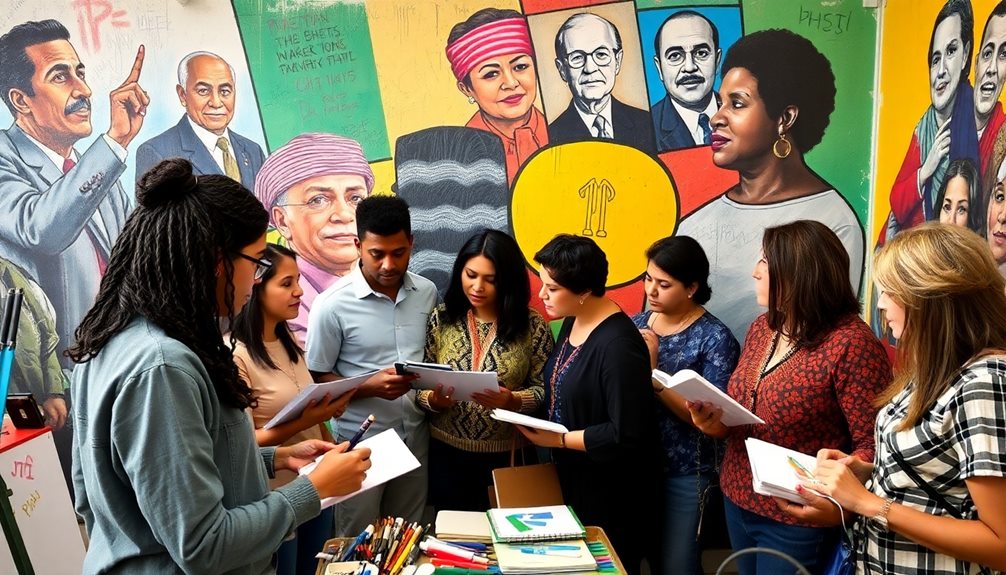
When you analyze art, start by examining the visual elements like line, shape, and color to grasp the artwork's impact.
Don't forget to reflect on the context behind the piece, as historical and cultural factors play a significant role in its interpretation.
Visual Elements Examination
Understanding the visual elements of an artwork is essential for effective analysis. By examining these aspects, you can better appreciate how they influence the narrative context and provoke an emotional response. Here's what to focus on:
- Size and Orientation: The overall dimensions and whether the piece is portrait or landscape can shape your engagement.
- Formal Elements: Compositional techniques like the rule of thirds or golden ratio guide your eye, enhancing visual impact.
- Line and Shape: Consider the types of lines—dominant, linear, or gestural—and the visual language of shapes, whether geometric or organic, as they communicate the artwork's tone.
- Texture and Color: Analyze how textural qualities, tonal range, and color schemes evoke specific moods and influence your feelings about the piece.
- Spatial Arrangement: Pay attention to how elements are placed within the composition; their relationships convey storytelling and enhance the artwork's narrative context.
Contextual Analysis Importance
Contextual analysis serves as an essential lens through which you can uncover the deeper meanings behind an artwork. By examining the political climate, historical events, and cultural influences surrounding its creation, you gain valuable insight beyond mere visual elements.
Understanding the artist's background—like their upbringing and experiences—can also shed light on the themes and messages embedded within their artistic expressions.
Recognizing the impact of established genres—whether historical, religious, or abstract—enhances your interpretation, as each genre carries specific connotations that inform its context.
Additionally, artworks often respond to or reflect societal shifts and social movements, emphasizing the importance of the political climate during their creation.
Contextual analysis complements formal analysis, helping you connect the content and form of an artwork with its cultural and political implications.
This approach fosters a deeper comprehension of the artwork's message, enriching your overall appreciation and understanding.
Symbolism and Meaning
Examining the layers of symbolism in artwork can reveal profound meanings that resonate with viewers. Understanding the nuances of symbolism and iconography allows you to uncover deeper themes.
For instance, a raised fist symbolizes resistance and solidarity in social movements. As you analyze art, consider how various elements evoke emotional responses. Color plays a significant role here; warm colors can ignite passion, while cool colors often evoke calmness.
To enhance your analysis, keep these key aspects in mind:
- Symbolism: Look for symbols that convey deeper meanings.
- Iconography: Recognize specific images that represent complex themes (e.g., doves for peace).
- Emotional Responses: Consider how color influences feelings about the artwork.
- Juxtaposition: Notice contrasting elements that provoke thought (e.g., light vs. dark).
- Titles: Analyze how the title shapes your perception and interpretation of the piece.
Contextual Understanding of Artworks

When you explore the world of art, recognizing the historical and cultural contexts surrounding each piece can profoundly enhance your appreciation. Every artwork is a product of its time, shaped by political climates and social movements that influenced the artist. Understanding the cultural context allows you to grasp the underlying themes and messages embedded in the work.
Consider the key biographical details of the artist—upbringing, psychological state, socioeconomic status, and education. These factors play an essential role in how the artist perceives the world and conveys their thoughts through art. Established genres, like landscape or portraiture, provide frameworks that inform your interpretation, revealing insights into identity and social status.
Art doesn't exist in a vacuum; it's a reflection of broader societal values and issues. By examining the interplay between the artwork and its time, you gain deeper insights into past cultural and political dynamics.
This understanding not only enriches your experience but also connects you to the ongoing dialogue within the art world, allowing you to appreciate the significance of each piece in its unique context.
Career Opportunities in Art and Politics

Steering through the dynamic intersection of art and politics opens up a variety of career opportunities that allow you to engage with both fields meaningfully.
Whether you're interested in shaping public discourse or advocating for social change, there are numerous paths you can explore.
Here are some exciting career opportunities at this intersection:
- Museum Curators: Organize exhibitions that reflect political themes and engage communities.
- Political Consultants: Use visual communication strategies in campaign materials to convey political messages.
- Arts Administrators: Advocate for the arts within policy frameworks, managing institutions that highlight political and social issues.
- Art Educators: Teach art history and criticism, fostering discussions that connect artistic expression with civic engagement and social movements.
- Community Outreach Coordinators: Develop programs that utilize art for social change, focusing on local issues.
Frequently Asked Questions
What Is the Connection Between Art and Politics?
Art and politics intertwine deeply; you'll see how artists reflect societal issues and critique power structures. Through various movements, art becomes a powerful tool for inspiring change and voicing marginalized perspectives in your world.
What Are the 4 Four Steps of an Art Analysis?
Art analysis is like solving a magnificent puzzle! You'll describe the visuals, interpret meanings, evaluate effectiveness, and contextualize within history. Each step helps you uncover the artwork's secrets and understand its deeper significance.
What Are the 3 Main Parts of an Art Analysis?
The three main parts of an art analysis are formal, contextual, and interpretive analysis. You examine visual elements, consider historical contexts, and explore themes and emotions, deepening your understanding and appreciation of the artwork.
How Do You Structure an Art Analysis?
To structure an art analysis, you'll start with essential details like title and artist. Next, examine formal elements, context, symbolism, and conclude with the emotional impact, connecting it to contemporary issues.
Conclusion
In exploring the intersection of art and politics, you uncover the power of expression, the weight of history, and the influence of ideology. By analyzing political dimensions, you grasp the impact of art as a catalyst for change and a mirror of society. Embracing techniques for art analysis, you deepen your contextual understanding and open doors to exciting career opportunities. Ultimately, you realize that art isn't just about beauty; it's a vibrant dialogue with the world around you.



